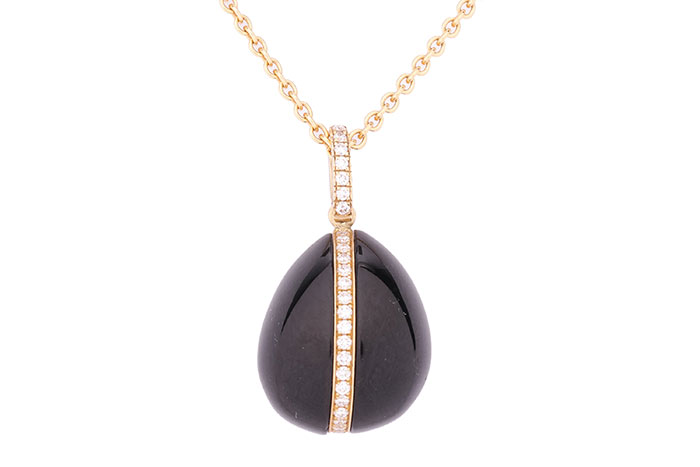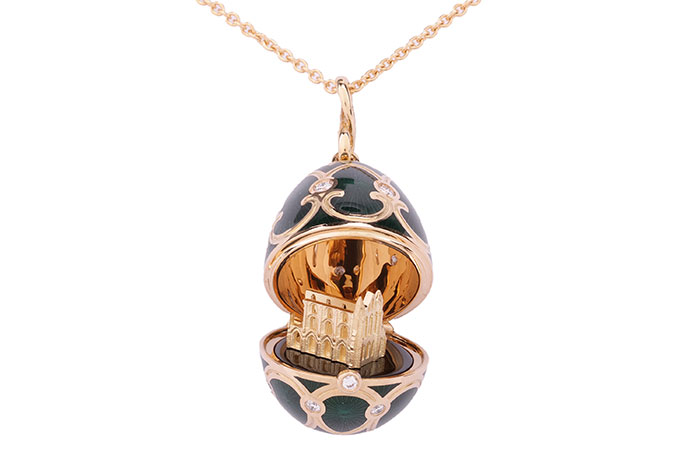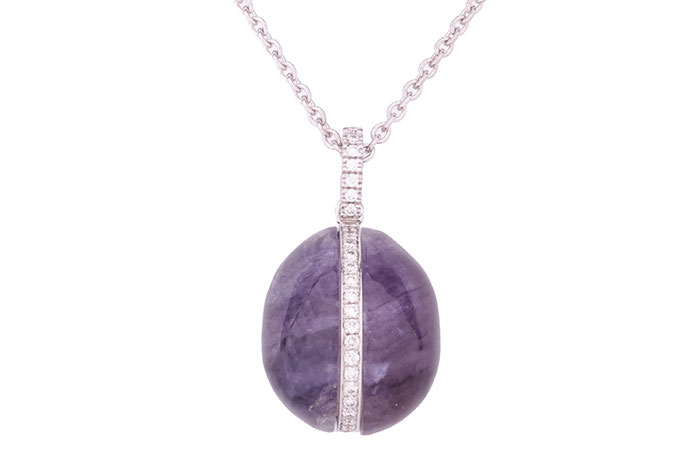A Guide to Fabergé
The house of Fabergé is undoubtably one of the most prolific names in luxury
02/01/2025
Fabergé is a name that has long been synonymous with exquisite craftsmanship, unparalleled artistry, and the epitome of luxury. They were the leading jewellery firm of their time, ahead of luxury counterparts such as Cartier and Tiffany & Co. to name a few. As one of the finest goldsmiths and jewellers of all time, Fabergé's legacy continues to captivate collectors and enthusiasts around the world.
Gustav Fabrier was born on the 18 February 1814 in Pernau (now Pärnu) in Livonia (present-day Estonia). His French refugee Huguenot descendants had changed the family name throughout their 140-year progression across Europe, originally Favri, then Favry, to Fabri, then Fabrier. In 1826 Gustav’s older sister, Catharina Fabrier, changed her maiden name on her marriage ledger to Faberge, and as a teenager Gustav adopted this version too.
A Fabergé heritage yellow gold diamond & guilloché enamel Cathedral surprise pendant
In the 1830s, Gustav moved to St Petersburg in Imperial Russia to apprentice as a goldsmith under gold box master Andreas Ferdinand Spiegel, later taking a position at Keibel, who became goldsmiths and jewellers to the Tsars (Russian Emperors) during Gustav’s employ.
Gustav qualified for the title Master Goldsmith in 1841; the following year he married Charlotte Jungstedt and opened a basement level jewellery store in Bolshaya Morskaya Street, which he called Fabergé. During his time in St Petersburg, Gustav would have become aware that Russian nobility was very keen on most things French, including style and language. As a result of Catherine the Great’s reign, French had been adopted as the official language of Russia’s royal court and was widely used amongst aristocracy. The addition of the acute accent (to his surname - Fabergé) was no doubt intentional to appeal to Russia’s wealth who associated luxury goods with the French.
 A Fabergé Whitby jet egg pendant
A Fabergé Whitby jet egg pendant
On the 30th of May 1846, Gustav and Charlotte welcomed their first son, Peter Carl Fabergé, who would become widely known as Carl Fabergé. Upon leaving school, Carl undertook a Grand Tour of Europe, visiting museums, libraries, art galleries, stately homes, palaces, and local craftsmen. He trained as an apprentice to Master goldsmith Josef Friedman in Frankfurt, Germany, whilst he completed a course at Schloss’s Commercial College in Paris, France, and also travelled to England to learn English.
When Gustav retired in 1860, he moved the family to Dresden, leaving the business in the capable hands of trusted managers. Two years later Agathon, Carl’s brother, was born and by 1864 Carl returned to St Petersburg to join the firm where he honed his skills under the tutelage of his father and in-house workmaster, Peter Hiskias Pendin, who became Carl’s mentor, tutor, and confidant.
While records vary, Carl took control of the firm sometime between 1870 and 1872, moving the store premises to a ground floor space opposite the original basement workshop. Throughout the 1870s Carl consulted for the Imperial Hermitage Museum providing services such as descriptions, repairs, and restoration to ancient gold jewellery pieces.
Following the passing of Pendin in 1882, Carl took sole responsibility of the firm and his brother, Agathon, joined the family business. Agathon displayed a talent for design and brought a fresh impetus into the trade (sadly, his contributions were short-lived as he passed away thirteen years later at the young age of thirty-three). That same year Carl was awarded a gold medal at the Pan-Russian Exhibition in Moscow for his accurate replicas of ancient objects, earning the title of Master Goldsmith. The accuracy and meticulous execution of his creations drew the attention of the new Tsar, Alexander III.
A Fabergé blue john egg pendant
In 1884 Fabergé received their first commission from the emperor, an Easter present for his wife, Empress Maria Feodorovna. The first Imperial Easter Egg was presented to the Tsar in 1885, who was so delighted with the bejewelled work of art that Fabergé was appointed jeweller and goldsmith to the Russian imperial court. The Imperial surprise Easter Egg became a tradition with the Crown, each year Fabergé would create a jewelled egg for which they had complete creative freedom. Crafted by a team of expert goldsmiths, silversmiths, jewellers, gem cutters, engravers, enamellers, and polishers under the supervision of Carl Fabergé and his managers, each egg was a unique masterpiece that took a considerable amount of time and skill to create.
Throughout the last two decades of the 19th century, the House of Fabergé advanced to attain global recognition, while also achieving international awards and commissions. They had branches in Moscow (opened 1887), Odessa (opened 1901), London (opened 1903) and Kiev (opened 1906). At its peak at the turn of the 20th century, the House of Fabergé was the world's largest enterprise of its kind, employing roughly 500 craftsmen. The company's attention to detail, technical execution, and extraordinary use of enamels, set Fabergé's imaginative creations apart from the rest.
Their repertoire extended well beyond the infamous Easter eggs to include a diverse range of luxury goods, from jewellery, timepieces, picture frames and carved hardstone ornaments, to perfume bottle, spoons, bellpushes, boxes and handles; indeed, thousands of objets d'art were created by the atelier for the world’s most discerning and prosperous clientele including European royalty.
After the death of Emperor Alexander III in 1894, his son Tsar Nicholas II continued the custom, ordering not one, but two Imperial Eggs each year for his mother and his wife, Alexandra Feodorovna. A total of 50 eggs were produced, today only 43 are accounted for and these Fabergé eggs are among the most valuable and sought-after antiques in the world.
When the Great War broke in 1914, the demand for luxury goods fell. Fabergé had no choice but to utilise inferior metals, for example copper, to create items such as cruets, plates, mugs, and snuffboxes. They also made syringes, equipment, and military parts, such as grenades.
In 1917 The Russian Revolution broke. The following year The Russian Imperial Romanov family were all killed by Bolshevik revolutionaries. The House of Fabergé was confiscated and pillaged by the Soviets, before becoming nationalised. The Fabergé family were forced to flee Russia, Carl escaped on the last diplomatic train to Riga using false documents listing him as a courier for the British Embassy. He died a refugee in Lausanne, Switzerland in 1920.
After the revolution ended, Carl’s sons Alexander and Eugène, together with designer Andrea Marchetti from the Fabergé store in London, which had closed in 1918, set up Fabergé & Cie in Paris. The business created jewellery and objets d’art, which were clearly marked Fabergé, Paris to avoid any confusion. They also traded and restored historic Russian Fabergé pieces. The firm closed in 2001.
In 1937 an American of Russian descent, Sam Rubin, started a perfume business which he branded Fabergé and formed Fabergé Inc. Despite this being done without the family’s permission, it wasn’t until 1951 that the Fabergé descendants decided to settle out of court to avoid high legal fees. The Fabergé brand passed hands several times throughout the remainder of the 19th century before finally being reunited with the Fabergé family in 2007. The Fabergé Heritage Council was established the same year, with the sole purpose “to guide the company in its pursuit of Fabergé’s original heritage of excellence in creativity, design and craftsmanship.”
The house of Fabergé is undoubtably one of the most prolific names in luxury. Surviving examples of the wares produced under the direction of visionary Peter Carl Fabergé remain a testament to an era where skilled artisans possessed a real love of creation and thrived in an unhurried work environment.
read more
How to Identify Faberge Jewellery
How Do I Sell Unwanted Jewellery?
How Do I Know if my Jewellery id Valuable?

Nicky Houston
Our Head of Jewellery, Watches & Silver... Nicky is a highly respected Auctioneer & Valuer, who had dreams of becoming an artist. Whilst she may not have made it as a successful artist herself, Nicky has helped many a customer to successfully sell and buy beautiful pieces of jewellery and works of art over her many years working within the auction industry.
Jewellery Silver & Objects of Virtue Watches
Are you considering selling any Fabergé jewellery or luxury wares?
With a global audience of over 10 million known bidders, Dawsons can secure the best prices for you.
Get in touch with an expert valuer for confidential sales advice, we would be delighted to help:

